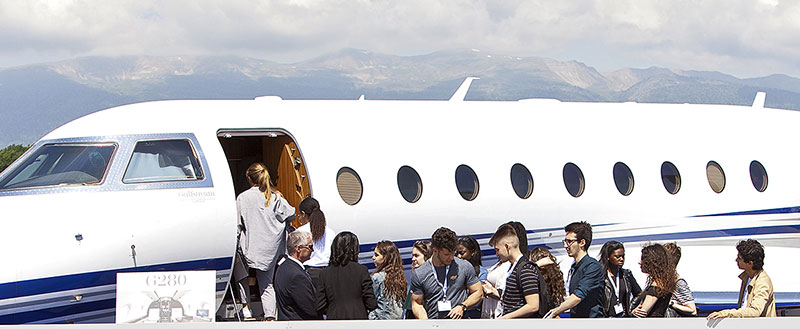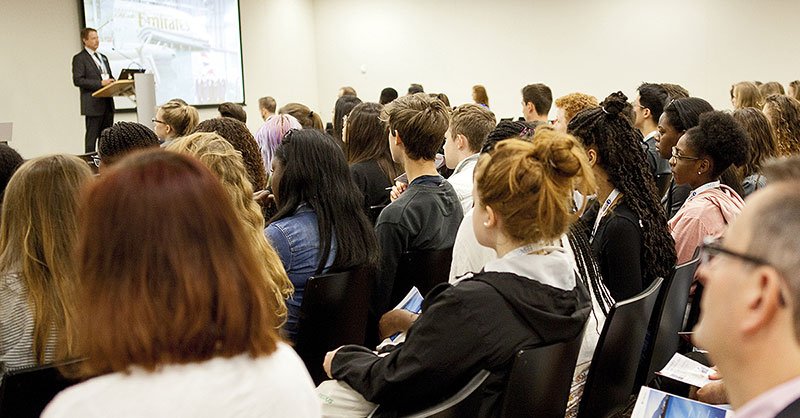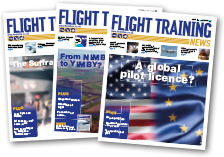In the first part of this article, the efforts of airsports organisations such as the British Gliding Association and the Light Aircraft Association to attract new, young, pilots into aviation were detailed. The second part of this article looks at what is being done in other sectors of aviation to ensure that the current generation of aviators does not represent a ‘high water’ mark in pilot numbers.
While airsports groups have led the way in encouraging new members to join their ranks, there are those who remain cynical about the ‘cult of youth’ when it comes to attracting ‘fresh blood’ into the flying world. After-all, even the most casual observer at a typical General Aviation airfield will notice that the average age of the participants is somewhere beyond any reasonable definition of ‘youth’. Many flying schools and clubs in particular have an age profile much closer to ‘early retirement’ than ‘starting career’ and it has long been the case that a significant number of new starters in most flying activities are ‘mature’ adults who have often waited until work and family commitments have reduced to the extent that they have both the time and money to indulge in a flying hobby. As longevity increases in the general population with people living, and working, to much older ages than even 50 years ago, surely there must be an argument for encouraging the older, rather than the younger, end of the population into flying? After-all, 70 is no longer considered particularly old for a pilot and there are an increasing number of active pilots well into their 80s (and more examples of pilots flying into their 90s). Just as it is no longer unusual for adults to make a compete ‘career change’ in their late 40s or 50s, and with the state retirement age in the UK set to become 66 by 2020, there must be a very strong argument that looking for new pilots in later life, rather than in their youth, may be a more effective way of increasing the pilot population. There is also a quietly-voiced concern that some younger pilots may simply be taking advantage of financial incentives to fly as ‘something to do’, rather than being dedicated aviators.
The counter-argument is supported by almost any instructor who has taught a ‘mature’ adult to fly. When asked why the student has waited for so long before starting to fly, the answers normally revolve around the financial and family commitments of those in their 20s and 30s, almost invariably accompanied by the observation that the new student ‘always wanted to be a pilot’.
This anecdotal evidence is backed-up with data from a recent survey by ‘PrivateFly’ – a leading global booking platform for private jet charter. The survey interviewed 1315 professional pilots about their work, lifestyle and views on flying. The pilots were asked to choose the main reason they became a pilot, and the overwhelming majority (76%) answered that they had always wanted to be a pilot since childhood. A further 11% answered that they had become a pilot because a parent or other family member had been a pilot.
In short, some 87% of the professional pilots surveyed have some sort of childhood connection with flying.
Based on such strong evidence that the desire to be a pilot originates in childhood in the overwhelming majority of professional pilots, it is clear why aviation organisations are making such concerted efforts to reach out to young people.
The growing efforts in actively attracting young people to develop an interest in aviation is nowhere more evident that at almost any aviation event open to the general public. As recently as the late 1980s, the annual gathering of a large pilot organisation would feature a ‘Ladies tent’ and a crèche, both apparently based on the assumption that women and children would have no interest in the aviation activities taking place all around. Now, aviation events worldwide make conspicuous efforts not only to attract young people (for example with free or heavily discounted tickets, often distributed through local schools) but also to promote a longer term interest in aviation amongst younger visitors. At the recent EAA ‘Air Venture’ event at Oshkosh – the world’s biggest General Aviation gathering – 17 volunteer pilots provided flights to 25 ‘Young Eagles’ to commemorate the 25th anniversary of the Young Eagles programme. The success of the ‘Young Eagles’ effort was underlined by one of the pilots himself. In the mid-1990s, Joe Corragio was simply a kid interested in aviation. Then, he became involved with EAA’s Young Eagles program shortly after its inception and aviation soon became a career, and more broadly, a lifestyle. Joe is now a professional pilot, and for him, flying new Young Eagles’ was about giving back to something that so heavily influenced the course of his life: “It’s really neat. It’s a cool way to showcase the Young Eagles program,” Joe said. “The Young Eagles program has done so much for me. It’s really an honour to give back to the programme. I don’t do as many Young Eagles flights as I would like, but being able to do them here at Oshkosh, and show the rest of the folks that are here the celebration of the 25th anniversary of the Young Eagles program, is a really cool opportunity.” It is perhaps not a co-incidence that the annual EAA gathering was reportedly the best attended ever (590,000 people over seven days, a 5 % increase on 2016). For those who regard social media as a youth-driven phenomena, the on-line viewing figures are also instructive. According to the EAA, more than 15.4 million people were reached by EAA’s social media channels during AirVenture (double the 2016 total); EAA AirVenture app had 1.7 million screen views; EAA video clips during the event were viewed 2.2 million times; and EAA’s 1,900 photo uploads were viewed more than 9.8 million times. Also, EAA web streams were accessed more than 500,000 times by viewers in 192 countries, who watched more than 110,000 hours of activities from the AirVenture event.
Meantime in Europe, the 2017 European Business Aviation Convention and Exhibition (EBACE) hosted its first ‘Careers in Business Aviation Day’. More than 250 high school, vocational and university students from 120 schools across Europe attended this year’s event – all for free – hoping to learn more about jobs in a field they knew little about.
“This is a very people-intensive industry,” Simon Witts, the founder and CEO of Aviation Skills Partnership, told the assembled students. “That’s lucky for you. The world is facing a critical shortage of aviation personnel.”
Two year earlier, Jared Camaddo, a business student at Geneva’s André-Chavanne College and Business School, searched online for training or internship programs in aviation. He found that EBACE was held every year down the street from his school, and was amazed by the breadth of career possibilities in business aviation.
Attending the 2017 event, Camaddo said: “I know a lot of people of my age who would be interested in these careers, they just don’t know about them,” he said. “Before I came to EBACE, I didn’t know this was an industry that needs people.”


Witts told the students that, just on the operations side of business aviation, career pathways are available for pilots, air traffic controllers, ground technicians, dispatchers, cabin crew, engineers and maintenance technicians.
The need for more new people to come into aviation is underlined by the latest global forecasts from Boeing. The ‘headline’ figure is that over the next 20 years, Boeing forecast that 637,000 new airline pilots will be needed to support worldwide airline growth (a 3% increase on the 2016 figure) – it is also notable that the global airline business will also need 648,000 new maintenance technicians and 839,000 new cabin crew over the next 20 years. The Boeing report also notes that: “Educational outreach and career pipeline programs will be essential to inspiring the next generation of pilots, technicians, and cabin crew. Early student engagement and defined aviation career paths will help expand the reach to new demographics. The growing diversity and mobility of aviation personnel will require instructors to have cross-cultural, cross-generational, and multilingual skills to engage with tomorrow’s workforce.”
Meantime, back at grassroots aviation, a small airfield in south west England is taking positive action to address an ageing pilot population. Henstridge airfield owner Geoff Jarvis has launched an initiative providing heavily discounted training to youngsters under the age of 25, in order to lower the average age at the airfield from its current mid-60s position: “Our membership is made up of predominately retired professionals and this can’t but help in perpetuating the myth that flying is financially out of reach to youngsters. We are actively encouraging youngsters to join the airfield and learn to fly, and in order to assist them with their training costs we are allowing them to use our training aircraft at cost.
To date we’ve had about half a dozen new students train at Henstridge, all of whom have been under the age of 25. Some have got their PPLs as the first step on their commercial flight training journey, while others wish to continue flying GA aircraft as a hobby rather than a profession. Whatever their stated goal – and it’s been interesting to note that a couple have changed their minds halfway through, deciding to take up the commercial pilot challenge – having a younger demographic at Henstridge is a massive bonus in terms of the future viability of the airfield.”
In an era of locked cockpit doors, ever higher financial barriers to an airline pilot career and concerns over the social diversity of the airline pilot workforce, it’s questionable whether the world’s airlines have yet got the message that the rest of the aviation world seems to have already heard loud and clear.







